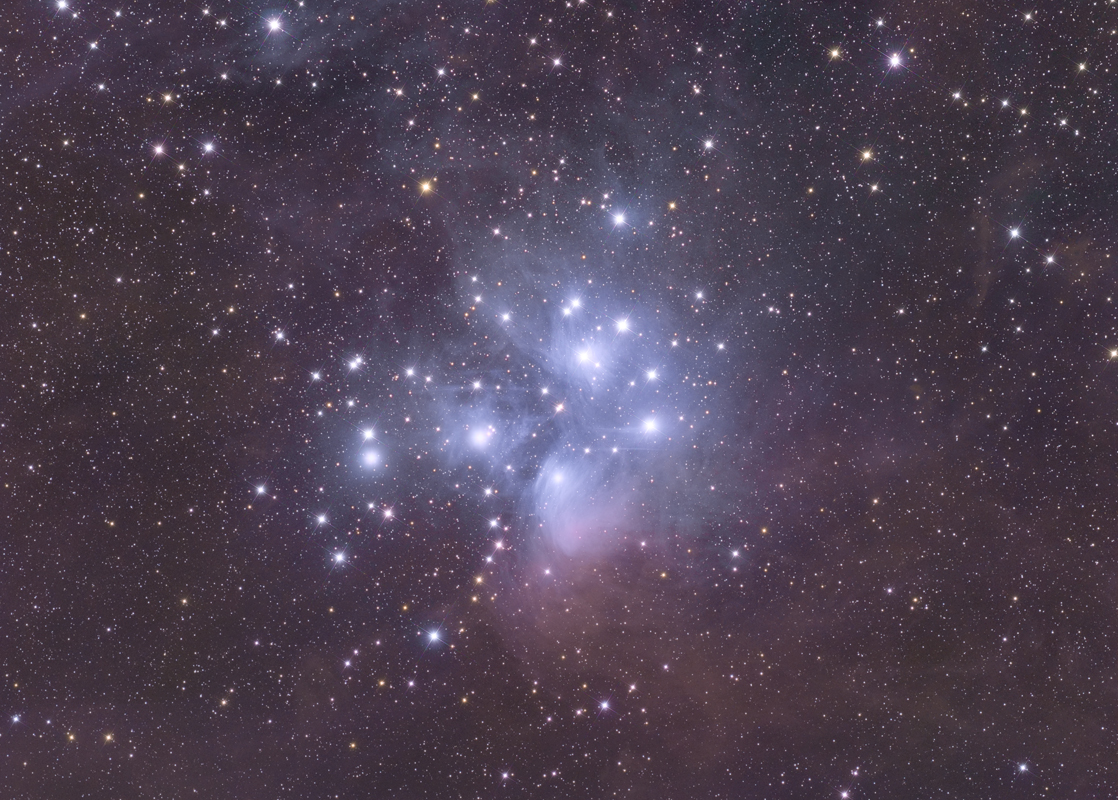The Pleiades (M45)
Characteristics:
Magnitude: 1.6
Distance: 380 light years
RA: 3h 46m 31s
Dec: 23 degrees 57' 36"
Description:
This is the first light image of my new Apogee U16M camera coupled to
the FSQ-106N, a perfect widefield combination. The Pleiades (M45,
the "Seven Sisters")
convey a sense of stately, quiet winter beauty. This open star
cluster has been recognized since antiquity, with the oldest recorded
observation being approximately 1000 years BC. Within this
cluster, it is possible to resolve between 7-11 stars with the naked
eye, depending upon seeing conditions (and eyesight!). Through
the telescope, the cluster is known to contain about 500 stars that are
gravitationally bound to each other. The age of this cluster is
estimated to be about 65 million years old, meaning that it was "born"
around the time of the dinosaur extinction. The beauty of this
cluster is due to the impressive amount of blue nebulosity that appears
to surround many of the stars (although is most likely not physically
associated with the cluster).
Many images of M45 portray the blue reflection component very
prominently, often to the exclusion of the large amount of surrounding
dust in the area. When I examined the luminance and red frames,
it was clear that there was a large amount of dust that had a dominant
red signal, and I was careful to not process this out of the
image. The result is a somewhat unconventional view of the
Pleiades, that shows the dominant blue reflection component in close
proximity to the open cluster itself, but also captures the surrounding
dust that is too far away from the cluster to scatter blue light, but
which is part of the same dusty region of space. Close
examination of this image shows how the blue reflection component
interdigitates within the red dust, especially prominent in the
upper left hand portion of the FOV. A nice description
of M45 can be found on Rob Gendler's website.
I am dedicating this image to the memory of Daniel Marquardt, a fellow
astrophotographer who recently passed away at the age of 27.
Danny was recently recognized for his achievements by the Advanced
Imaging Conference Pleiades Award, making it appropriate to use my
image of the Pleiades to call attention to his many contributions to
this hobby.
Photographic Details:
Date: November 20 and 21, 2009
Scope: Takahashi
FSQ106 at f5 on the Takahashi NJP
Mount
Autoguider: SBIG ST-402 with
60mm guidescope, focal length 227mm
Camera: Apogee U16M at -20C, with
7 position 50mm square filter wheel (Apogee FW50-7S)
Filters: Baader LRGB
filters, 50mm square
Exposures: Luminance 150'; R 45'; G 40'; B 60',
unbinned.
Total
exposure 4.9 hours
Post-processing:
Calibrated, aligned, and Sigma Clip combined
in Maxim, followed
by DDP
in ImagesPlus (IP). Further processing in Photoshop CS (16
bit format). Star spikes were added during processing using a new
program by Noel Carboni (Star Spikes Pro).
Although I generally don't like too much manipulation post processing,
I find this program to provide excellent control over star spike
characteristics, and I also like the look of diffraction spikes for
certain objects like star clusters (as long as they do not dominate the
image).
Please
note: Graphics on this website may not be reproduced without
author permission.
Back to Star
Clusters
Home

